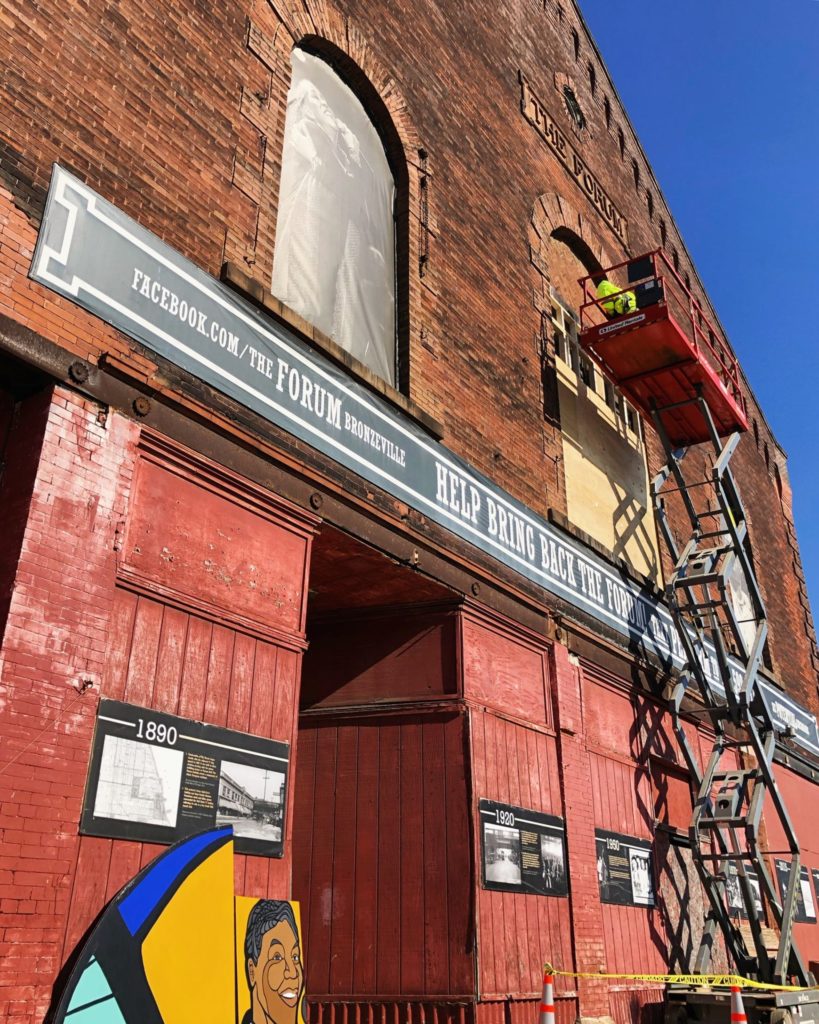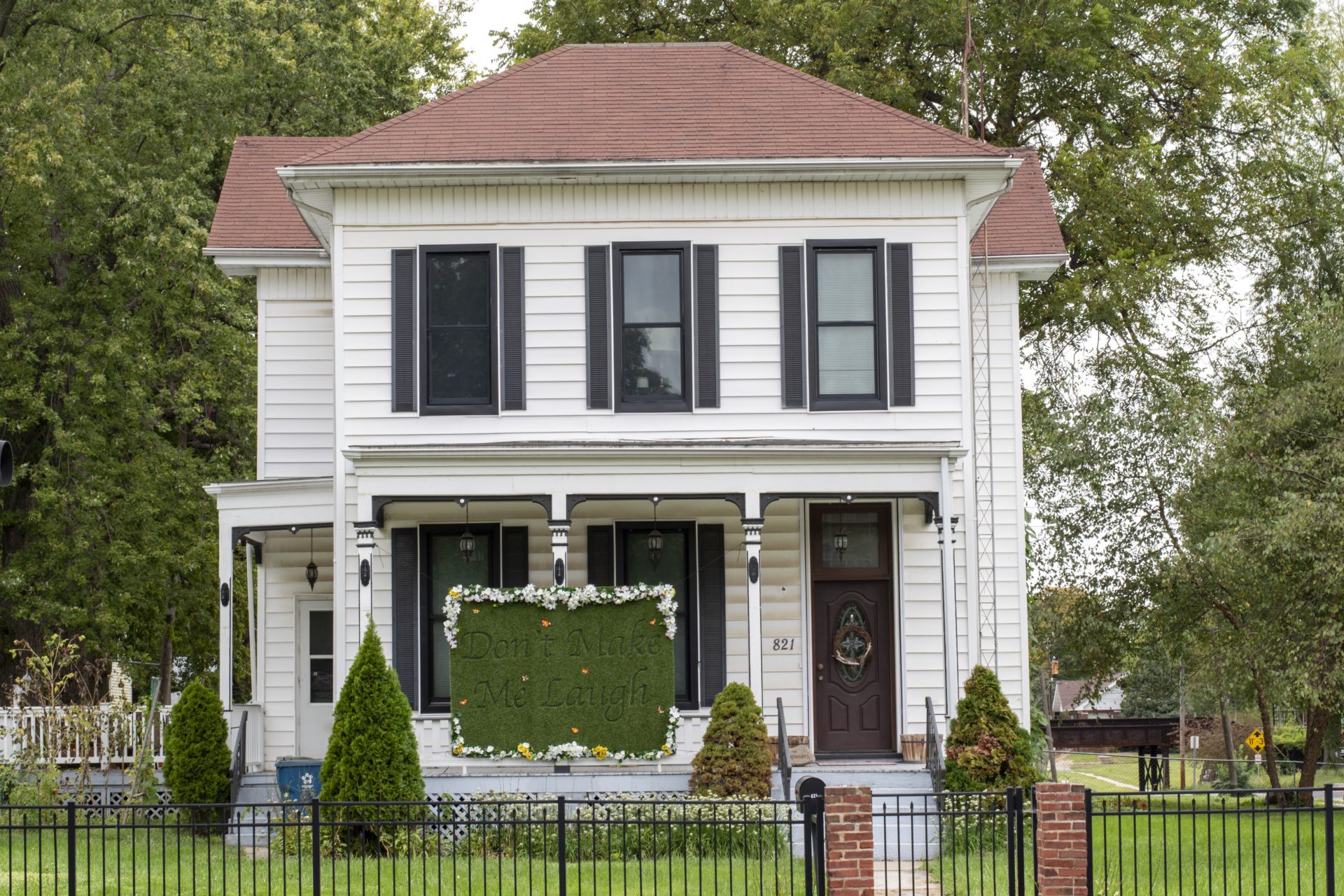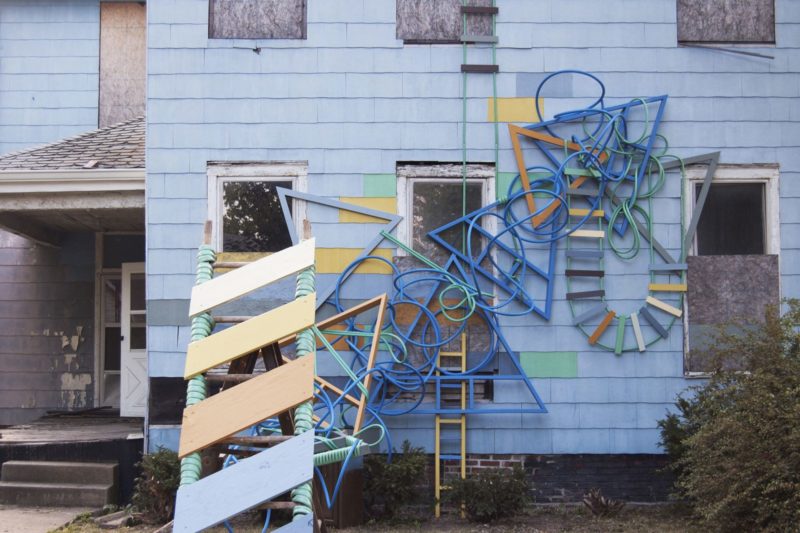September 7, 2021
By Julie Carpenter, Landmarks Illinois Programs Manager
(This article was originally published in the August 2021 edition of The Arch newsletter.)
Art and architecture have always been natural bedfellows, and for the preservation movement, artists play a particularly vital role in bringing awareness to places that are important to cultural heritage and social histories.
This is especially true for socially engaged artists, who work outside of the museum realm in search of site-specific opportunities that create a dialogue between residents, community organizers, city officials, urban planners and developers and whose work is often used as an instrument for public change. Colorful murals and contemporary art installations that adorn the facades of historic buildings are not only attention-grabbing, but have the power to reconstruct a structure’s identity in ways that allow us to imagine a new future.
The merger of art and preservation is also a convincing and provocative catalyst for economic development. The presence of artists at work in communities, especially in neighborhoods that have experienced disinvestment, sends a strong message that these places are viable, vibrant and worth preserving. Landmarks Illinois recognizes the transformative sway that art brings to preservation advocacy and increasingly supports artists through grant funding and reinvestment initiatives.

(Sam Kirk’s art is installed on the Forum. Credit Erica Ruggiero.)
In Bronzeville, Erica Ruggiero and other members of Landmarks Illinois’ Skyline Council commissioned Chicago multidisciplinary artist, Sam Kirk, in 2019 to create a mural at The Forum, helping to activate the historic and culturally significant site. Listed on Landmarks Illinois’ Most Endangered Historic Places list in 2018, The Forum, built in 1897, once served as a prominent music venue and assembly hall for civil and labor rights meetings, but decades of vacancy and neglect have left it in need of extensive rehabilitation.
Since 2011, The Forum’s owner and nonprofit, Urban Juncture, has been fundraising to renovate the building and restore this cultural institution, while plans for high-quality retail and hospitality offerings aim to revitalize commerce in the community. Kirk’s 2019 mural pays tribute to jazz great Nat King Cole, who performed at The Forum. This and flanking murals of Margaret Burroughs and Gwendolyn Brooks by Chicago painter Dorian Sylvain and her artist sons Kari, Kahari, and Katon form a multi-panel altar for this South Side shrine to art and culture, while inspiring the next generation of musicians, artists and poets.

(St. Louis artist Yowshien Kuo’s work, “Don’t Make Me Laugh,” on the front porch of an Enos Park home that “ironically points to false historical narratives that continue to resonate within America’s relationship to intellectual and social ownership.” Courtesy Terrain Exhibitions.)
In Springfield’s historic Enos Park neighborhood, the nonprofit art organization Terrain Exhibitions brings experimental contemporary art installations to places where it is most needed and least expected: yards, front steps, windows, porches and roofs. Together, Enos Park’s architecture and evolving social history provide an alluring and important backdrop for artists.
Once known as the “Jewel of Springfield,” Enos Park is a proverbial catalog of architectural styles – stately Victorian, Italianate and Queen Anne homes that date back to the early 19th century. From the 1930s to 1960s, many of these large, single-family homes were converted into multi-family rental properties, which contributed to the eventual decline of a diverse community that spanned from working-class, immigrant families to the most affluent and influential.
As the community transformed, areas of the Enos Park neighborhood became blighted, with many structures being condemned and demolished. In 1989, a group of concerned citizens formed the Enos Park Neighborhood Improvement Association (EPNIA), which Landmarks Illinois has supported via advocacy and grant funding.
In 2017, with support from EPNIA and the Springfield Art Association, Terrain Exhibitions embedded itself in the Enos Park neighborhood through its artist residency program and the Terrain Biennial. Over the last four years, Terrain artists have created sight-specific/sightresponsive art installations on the front lawns, porches, windows and roofs in Enos Park that address social history and the political landscape, while communicating narratives that are meant to provoke thought or motivate social change.
These “architectural interventions” are also a powerful act of decentralization, taking art from privileged urban centers and bringing it into everyday spaces where people live. Through their work, Terrain artists, as avant-garde preservationists, bring vitality to Enos Park and shine a light on the revitalization of the neighborhood, which has once again become one of the most ethnically and socio-economically diverse communities in Springfield.
(Top photo: A Terrain Exhibitions art installation by Heather Brammeier. Courtesy Terrain Exhibitions.)

